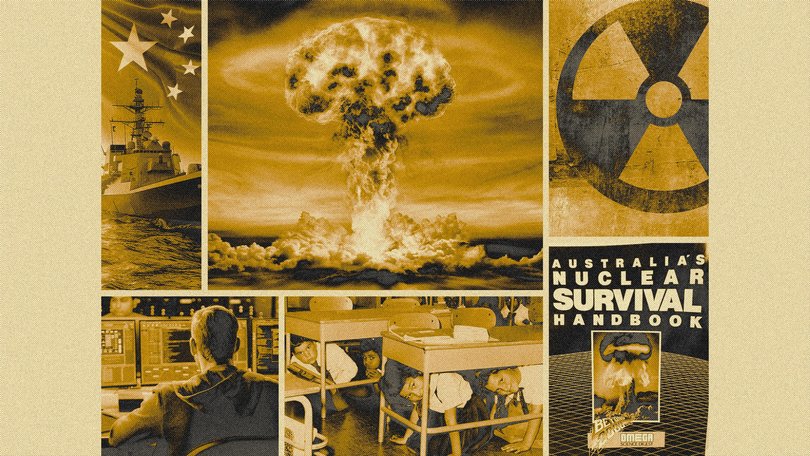Australia’s regional threats are mounting but there’s still no handbook on how to get ready for war

Last month British Prime Minister Keir Starmer reportedly ordered an update to 20-year-old civil contingency plans in case the nation suddenly found itself under attack and at war.
It was not that a strike by its openly named adversary Russia was imminent, although the Kremlin has threatened to expand conflict to Western nations assisting Ukraine in its war.
But more the realisation its classified plans - including bunkers, resource stockpiles and Royal Family and others’ evacuation routes - were outdated and did not reflect modern warfare, leaving the nation unprepared.
Sign up to The Nightly's newsletters.
Get the first look at the digital newspaper, curated daily stories and breaking headlines delivered to your inbox.
By continuing you agree to our Terms and Privacy Policy.With the Albanese government consistently referencing Australia now at its most “complex and threatening” set of strategic circumstances since World War 2 with multiple global flashpoints including about the South China Sea.
As recently as on the weekend Defence Minister Richard Marles warned of China’s rapid nuclear expansion and need to not be complacent about the regional destabilising threat.
What then civic defence plans do we have and are they up-to-date?
“We simply don’t know,” said former head of the Home Affairs Department Mike Pezzullo.
He left the department at the end of 2023 after about seven years in the chair and was previously in Defence and he says if there was one, he never saw it.
Australia does have a national crisis framework for dealing with “hazards” but it’s about governance, responsibilities and triggers for Commonwealth overriding State help rather than a detailed survival handbook.
‘Think the unthinkable’
Forty years ago, the bluntly titled “Australia’s Nuclear Survival Handbook” was produced in conjunction with a nuclear bomb threat special by the highly popular Seven Network science and tech TV series Beyond 2000.
The glossy 66-page manual complete with maps of all capital cities ring-marked with likely blast and fallout zones, as well as suggested food and water stockpile shopping lists, sparked national discourse designed as it was to prompt Australians to “think the unthinkable”.
It was the height of the Cold War and the 1985 booklet, which retailed for $3.50, proposed a threat scenario of a Soviet Union-United States conflict with Russian strikes on Australia from one of its then bases in Asia, Cam Ranh in Vietnam, targeting primarily military bases in Australia and critical installations including the US-Australian joint bases Pine Gap (NT), Harold E. Holt Communications Station (WA), Nurrungar/Woomera (SA), Jindalee Radar network in Laverton and Longreach as well as Australian military bases principally in Darwin (notably RAAF Tindal) and HMAS Stirling in Perth.
“I was a freelance journalist and I was asked to do it to coincide with the television show so I just did, researched from scratch,” author Laurie Strachan said on the anniversary of his work.

“But it wasn’t official - although people were surprised at how much detail we were able to put together.”
The manual included remarks from military chiefs and other prominent figures of the time but was produced with no government or official file access and its significance diminished along with the eventual thawing of the Cold War.
Australia had copied the British civic defence model with its own “Commonwealth War Book” in the 1930s, utilised it in the 1940s with the last version written in 1956 before crisis responsibilities were handed over to individual agencies to consider.
“That was the last version done,” Mr Pezzullo said yesterday.
“The difference between now and the 1950s of course is so many utilities and critical infrastructure providers are in private hands, hence the need to engage across the economy with very detailed stakeholder engagement to produce a (Home Affairs-led) document now.”
He said a more contemporary look at warfare would be needed such as large-scale cyber assaults on infrastructure, shipping trade blockades and knocking out communication and GPS systems before any missiles were launched.
“God forbid if war broke out and Australia was attacked, what would we do with rationing food, what would we do with safeguarding children for example if they were in area of hostilities - say northern Australia was being struck by missiles would children be evacuated to the south for instance?
“How would we ration fuel, how we would ration critical imports for agriculture such as fertiliser? If we had one (book) it would deal with those kinds of particulars.
“The Defence Department would have a lot of classified plans to fight a war but the department would not be there thinking about ‘do you take children out of childcare?’ That’s the problem.”
Scope of a crisis
In 2008 a review of “homeland and border security”, led by then Defence Secretary Ric Smith, identified fundamental gaps in emergency management and recommended a more integrated approach to national security activities.
The Australian Government Crisis Management Framework (AGCMF) resulted from this review and since its release the following year has been updated 11 times.
The AGCMF is the basis for the Australian Government’s response to crises including pandemics, natural disasters, terrorism, and cyber incidents, designating responsibilities for agencies with Prime Minister & Cabinet (PM&C) responsible for whole-of-government national security and intelligence policy coordination.
In 2023 PM&C commenced the first comprehensive review of the AGCMF notably since the National Emergency Management Agency (NEMA) was only established on 1 September 2022 - to provide national leadership and strategic coordination for crises preparedness, response, relief, recovery and reconstruction.
PM&C looked at crisis management plans from the UK, Germany, Canada, France, Japan and Singapore, and found its own plans lacked a centralised process to ensure crises threats were being addressed in planning and preparedness activities.
One workshop conducted as part of the review, was led by the national intelligence community with specific “classified scenarios” of future risks framed around “mega trends”, described as likely to have a transformative effect on a global scale, including pandemics, international conflict, cyber warfare, bioterrorism and climate change.
The 2024 revised AGCMF involved “significant reforms” and identified 60 plans that could be used depending on type and scope of a crisis and 14 specific hazards including two new hazards of “radiological /nuclear incidents” and “novel or ambiguous hazard” which cannot be anticipated or planned for. Radiological or nuclear incidents were identified as emerging hazards requiring further guidance and documentation as part of the consultation process for the 2023 AGCMF Review.
The review also led to the development of the Australian Government Crisis Management Handbook providing detailed high-level “operational principles for activation, escalation and deactivation of responses to significant crises” to support senior officials coordinating a response. The book – including details of some stockpiled resources like generators and water purification systems in Victoria and South Australia - warns of the threat of complex “consecutive, compounding and concurrent crises” is marked not for public dissemination.
But these plans do not go into detailed civic contingency plans ahead or during an attack.
A Home Affairs spokesman declined to either confirm or deny such a collated ‘war book’ existed or was being prepared.
“The Department of Home Affairs is constantly assessing Australia’s policy, legislation and capability settings to enhance Australia’s national resilience and ensure that Australia is able to respond flexibly to a range of potential future scenarios across the full crisis spectrum,” they said.
PM&C also declined to answer questions but in its own review acknowledged “Australia’s threat and risk environment is evolving, resulting in new hazards with increased intensity and duration” including increased digital connectivity (cyber-attack) and evolving national security environment.
Dr Alan Dupont, former government defence, intelligence and foreign affairs adviser and the CEO of geopolitical risk consultancy Cognoscenti Group, said while the upside was the government had crisis management plans there was insufficient guidance or legislative powers to mobilise Australian society in the event of war which was a prospect that had to be taken seriously.
“Civil defence and national mobilisation on a scale we haven’t seen since World War II is essential to preparedness and deterrence,” he said.
